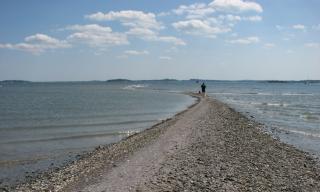Advertisement
You get two reactions when heading for a yurt on Peddock’s Island: “Are you crazy?!” or “Lucky you!” Frankly, I wasn’t sure which it would be: nature-filled glory right here in the Boston Harbor, or an ill-considered folly based in a small round tent. After all, realities to contend with include poison ivy, bad weather, mosquitos, and nothing to do. No food, either—and you have to haul your stuff from the ferry to the yurt. On the other hand, as the British might say, it “sounded a jolly spot” to me at least, and, okay, maybe it would offer a spiritual experience, too. So I went.
The island boasts four headlands connected by sand or gravel bars called tombolos. Tombolos? Tombolos, whatever they are, sounded fun, if not jolly.
And there’s fodder for the imagination: Native Americans lived there, and later, during the Revolutionary War, Patriot infantrymen confronted a Tory farm. I hear there was a Portuguese fishing village on Peddock’s. A thousand Italian prisoners of war lived on the island during World War II, taking over the cooking, getting paid to guard themselves, and regularly visiting Boston’s North End for evenings of dancing. Martin Scorsese filmed scenes for Shutter Island, starring Leonardo DiCaprio, on Peddock’s. So much human history, so much perspective.
You have your trees: maple, birch, oak, pine, poplar, sumac, and apple, and wild roses. Woodland paths. Truly dark night air. Birds. Views of Boston looking close enough to touch, rocky beaches, and yes, the yurt itself, spare and Thoreauvian. Excellent.
Let me be clear. I have a perfectly good place to sleep at home, less than an hour from the yurt, with screens in the windows, a coffee maker, and WiFi. I understand how obnoxious it is to crow about roughing it, about being able to get away from it all, to wax all romantic about Native Americans, Tory farmers, and Italian prisoners of war. I know that whole populations live their lives in small round tents. And yet I did treat myself to the island yurt, to shake myself loose from my complacency, my ruts, my narrow vision, with no hand-wringing at all. There it is.
“Real” adventurers scoff at yurts. Lovers of creature comforts bring on the pity. Busy people have better things to do.
It’s just that in the spirituality department, I need to be hit on the head with a two-by-four. That’s the long and the short of it. It works to pluck myself out of my little life and plunk myself into a different one, where nothing happens. A lazy minister’s strategy for spiritual awakening. A different view, different challenges, the routine shot to hell, and nature’s wonder close at hand. The awe comes easy.
And gratitude! Oh my! Get me outside myself, say, in a yurt on an island, and whoa—there are the stars, and crickets, the body I live in, the images of the people I love. The thankfulness piles on: I have teeth! Songs in my head. Sun on my back. Coffee! Thanksgiving writ large. I may not sleep too well there in my sleeping bag, and I claim the right to feel grouchy at daybreak, but suddenly I’m glad to lie in the dark within spitting distance of the waves and the skyline.
Chances are you won’t go the yurt-route to get into the spirit of Thanksgiving. Skyping with your kids, a serious dessert, working your way out of a jam, hitting the ball just right, a blast from the past, baking up a storm, a love lost then found, playing a tune, putting your feet up—something else will surely trigger your gratitude, I’m sure of it. But for me, this time, the yurt did the trick.
